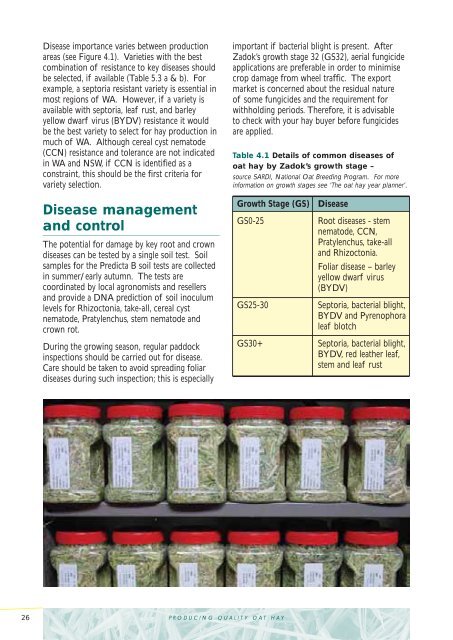Create successful ePaper yourself
Turn your PDF publications into a flip-book with our unique Google optimized e-Paper software.
Disease importance varies between production<br />
areas (see Figure 4.1). Varieties with the best<br />
combination of resistance to key diseases should<br />
be selected, if available (Table 5.3 a & b). For<br />
example, a septoria resistant variety is essential in<br />
most regions of WA. However, if a variety is<br />
available with septoria, leaf rust, and barley<br />
yellow dwarf virus (BYDV) resistance it would<br />
be the best variety to select for hay production in<br />
much of WA. Although cereal cyst nematode<br />
(CCN) resistance and tolerance are not indicated<br />
in WA and NSW, if CCN is identified as a<br />
constraint, this should be the first criteria for<br />
variety selection.<br />
Disease management<br />
and control<br />
The potential for damage by key root and crown<br />
diseases can be tested by a single soil test. Soil<br />
samples for the Predicta B soil tests are collected<br />
in summer/early autumn. The tests are<br />
coordinated by local agronomists and resellers<br />
and provide a DNA prediction of soil inoculum<br />
levels for Rhizoctonia, take-all, cereal cyst<br />
nematode, Pratylenchus, stem nematode and<br />
crown rot.<br />
During the growing season, regular paddock<br />
inspections should be carried out for disease.<br />
Care should be taken to avoid spreading foliar<br />
diseases during such inspection; this is especially<br />
26 PRODUCING QUALITY OAT HAY<br />
important if bacterial blight is present. After<br />
Zadok’s growth stage 32 (GS32), aerial fungicide<br />
applications are preferable in order to minimise<br />
crop damage from wheel traffic. The export<br />
market is concerned about the residual nature<br />
of some fungicides and the requirement for<br />
withholding periods. Therefore, it is advisable<br />
to check with your hay buyer before fungicides<br />
are applied.<br />
Table 4.1 Details of common diseases of<br />
oat hay by Zadok’s growth stage –<br />
source SARDI, National <strong>Oat</strong> Breeding Program. For more<br />
information on growth stages see ‘The oat hay year planner’.<br />
Growth Stage (GS) Disease<br />
GS0-25 Root diseases - stem<br />
nematode, CCN,<br />
Pratylenchus, take-all<br />
and Rhizoctonia.<br />
Foliar disease – barley<br />
yellow dwarf virus<br />
(BYDV)<br />
GS25-30 Septoria, bacterial blight,<br />
BYDV and Pyrenophora<br />
leaf blotch<br />
GS30+ Septoria, bacterial blight,<br />
BYDV, red leather leaf,<br />
stem and leaf rust

















